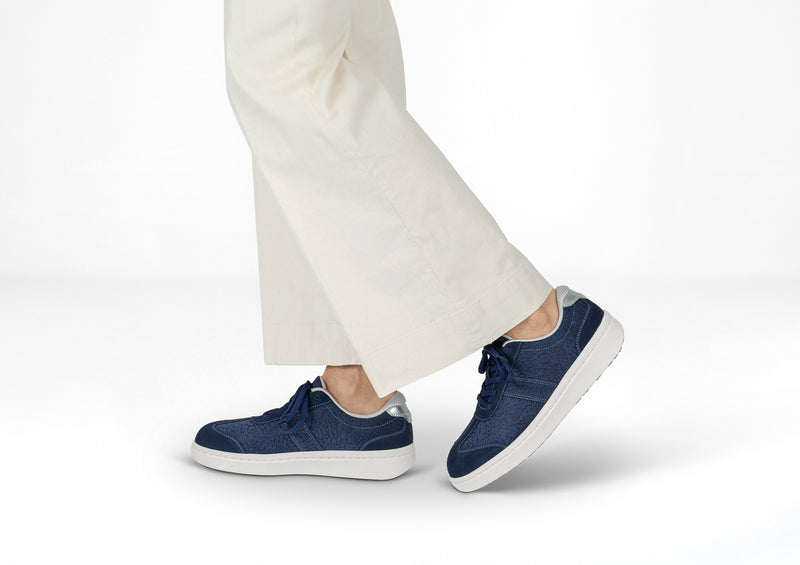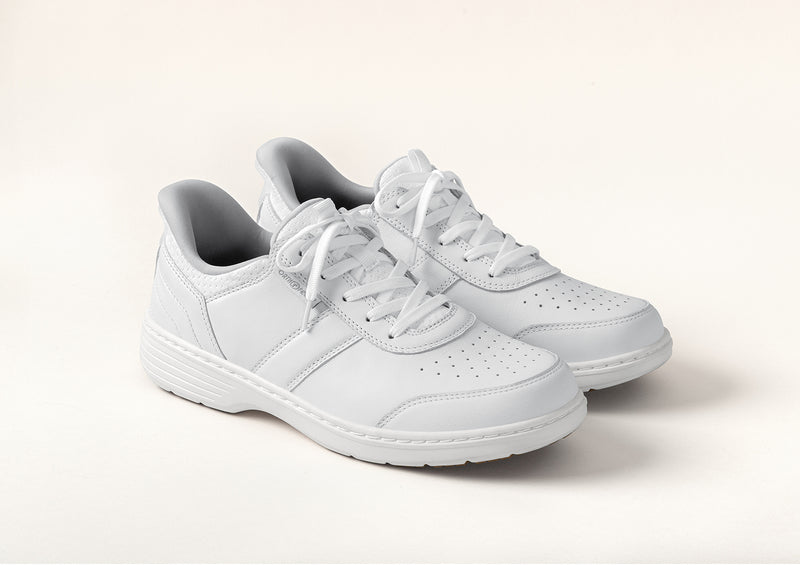Before we list our recommended shoes, first let’s get the definition out of the way.
Shin splints is a general term that refers to pain and inflammation in the lower leg, specifically along the shinbone (tibia). It is a common overuse injury that can occur in runners, dancers and other athletes who engage in activities that involve repetitive impact on the legs.
The exact cause of shin splints is not fully understood, but it is thought to be related to repetitive stress on the muscles and bones in the lower leg. This can lead to micro-tears in the muscles and inflammation of the connective tissue that attaches the muscles to the bone.
If you have shin splints, the following shoes can help support your healing process, but even if you don’t, these running shoes can also help prevent shin splints to begin with.
Best running shoes for shin splints for men
Sprint

Why you’ll love it
- Tie-less lacing
- Fasten and unfasten on both sides of the shoes
Specifications
- Sizes: 7-14
- Widths: D-6E
- Upper materials: soft fabric and microfiber
These shoes are designed with extra cushioning and support to help alleviate the pain and discomfort associated with shin splints, which means they are also the best walking shoes for men.
They have a wide toe box to accommodate foot swelling and provide a comfortable fit.
The Sprint also features a non-binding upper and an ergonomic sole to reduce pressure on the foot, and a roomy toe box that allows for natural toe splay, which can help to improve balance and stability while reducing the risk of foot and leg injuries.
As an added bonus, the Sprint sneakers have no less than three adjustable straps - two on either side of the shoe and one at the back - that allow you to fully customize the fit, eliminate the need to tie and untie laces, and enables fastening and unfastening on both sides of the shoe.
Sorrento

Why you’ll love it
- Pressure free fit
- Increased durability
Specifications
- Sizes: 7-14
- Widths: D-4E
- Upper materials: soft leather and fabric
The Sorrento sneakers are designed with an anatomical arch support that helps to reduce stress on the shin muscles and prevent over pronation, which is a common cause of shin splints.
A thick layer of cushioning in the insole absorbs shock and reduces impact on the feet, helping to prevent the jarring and pounding that can lead to shin splints.
With a lightweight and flexible design, the Sorrento allows for natural foot movement and reduces the risk of muscle strain and fatigue in the feet and legs.
The width of the sole, coupled with the firmness of the heel counter, further enhances stability, as does the unique tread design that provides exceptional grip and provides an assured feeling of steadiness with every step.
Yari

Why you’ll love it
- Hands free foot insertion
- Water repellent uppers
Specifications
- Sizes: 7-14
- Widths: D-4E
- Upper materials: stretch knit
Thanks to a unique hidden spring in the back of the shoe, you can put the Yari on without using your hands. By eliminating the need to bend down to put on or take off the shoes, these shoes can help reduce the strain on the muscles in the feet and legs, including the shins. This can potentially alleviate some of the symptoms of shin splints, such as pain and discomfort in the lower legs.
Support is one of the most important features when it comes to finding shoes for shin splints, and Yari offers plenty of it. The cushioned insoles reduce impact on the feet and legs; the added arch support provides better stability and support, keeping over pronation at bay; and the cushioning outsole with a mild rocker design helps you walk with greater ease.
The lightweight design allows you to walk with less effort, minimizing muscle fatigue in the feet and legs, and the upper’s breathable mesh material keeps the feet cool and dry.
Best running shoes for shin splints for women
Talya

Why you’ll love it
- Slip resistant
- Water repellent uppers
Specifications
- Sizes: 5-12
- Widths: B-2E
- Upper materials: soft synthetic leather
The Talya sneakers are made with professionals in mind and are designed with pain relief technology that’s perfect for people who spend long hours on their feet.
The uppers are made from soft, high-quality, water and stain repellent faux leather that’s also flexible to provide a non-binding fit.
The sole is slip resistant, so you can walk safely on any type of surface without losing your balance, which reduces the risk of slipping and falling. This is helpful if you have shin splints, as this condition is often caused by overuse of stress on the muscles and tendons in the shin area, and slipping or losing your balance can exacerbate the problem.
In addition, by improving your grip and stability, slip-resistant shoes can help reduce the stress and strain on your lower leg muscles and tendons, which can alleviate the symptoms of shin splints.
Coral

Why you’ll love it
- Breathable, aerated uppers
- Fully cushioned, yet lightweight
Specifications
- Sizes: 5-12
- Widths: B-2E
- Upper materials: stretch knit
With multi-layered cushioning in the insole of the Coral sneakers, impacts on your feet and lower legs are significantly reduced and excessive pronation is prevented, helping to alleviate pain associated with shin splints.
The Coral sneakers have a wide and deep toe box, which can provide extra room and reduce pressure on the toes and forefoot, improving overall foot comfort and reducing the risk of exacerbating shin splints due to cramped and tight shoes.
In addition, the lightweight and flexible design can help promote a more natural and comfortable walking motion. This can reduce the strain and impact on the lower legs, minimizing the symptoms of shin splints.
What all this means is that the Coral is not only great for running, but also the best walking shoes for women.
Kita

Why you’ll love it
- Easy on-off without bending
- Easy to clean, water-repellent uppers
Specifications
- Sizes: 5-12
- Widths: B-2E
- Upper materials: stretch knit
The Kita sneakers are constructed with a number of features that can help alleviate pain associated with shin splints.
The contoured orthotic insole provides arch support, which can help to distribute pressure evenly across the foot and reduce stress on the lower leg. The shoes also have a cushioned sole that can absorb shock and reduce the impact of each step, which can also help to reduce the pressure on the lower leg muscles.
The innovative construction of the back of the shoe allows you to insert your foot without using your hands or even bending down, helping to minimize pressure and ease pain caused by shin splints in the lower legs.
The insoles are expertly cushioned, including an anatomical arch support, and help to absorb shocks on the feet and legs as you walk. In addition, the mild rocker design improves the ease of walking.
With the Kita sneakers on your feet, you can walk with less effort and minimize muscle fatigue in the feet and legs, while the uppers are made from a breathable mesh material that keeps the feet cool and dry.
FAQ
Can running shoes help with shin splints?
Running shoes can certainly help with shin splints.
Shin splints are a common overuse injury that can be caused by a variety of factors, including improper footwear, but also over pronation, flat feet and weak lower leg muscles.
Proper running shoes can provide adequate support and cushioning to reduce the impact of each stride, which can help alleviate the pain of shin splints.
Shoes with a stable sole and a good arch support can help prevent over pronation, which can also contribute to shin splints.
However, it's important to note that it's also important to gradually increase your running mileage, stretch properly before and after your workouts, and incorporate strength training exercises for your lower leg muscles. Rest and ice may also be necessary to allow your body to heal.
Can my shoes cause shin splints?
Yes, your shoes can contribute to the development of shin splints.
Wearing shoes that don't provide adequate support or cushioning can increase the impact of each stride, leading to overuse and strain on the muscles and tendons in the lower legs. This can result in pain and inflammation in the shin area, which is known as shin splints.
In particular, shoes that are worn out, don't fit properly, or lack sufficient arch support can increase the risk of shin splints. Shoes with a high heel-to-toe drop or too much cushioning can also lead to poor running form and over pronation, which can further exacerbate the problem.
Therefore, it's important to invest in a good pair of running shoes that provide adequate support and cushioning and fit well. You should replace your shoes every 300 to 500 miles, or when you notice signs of wear and tear.
Will more cushioned shoes help shin splints?
If you are experiencing shin splints, shoes with additional cushioning can help reduce the impact of each stride and provide extra shock absorption, which can alleviate the pain of shin splints.
However, it's important to remember that overly cushioned shoes can also cause issues if they are not right for your individual foot and gait.
In addition to cushioning, other factors to consider when selecting running shoes for shin splints include stability, support and fit. A shoe with a stable sole and good arch support can help prevent over pronation and contribute to better running form, which can reduce the risk of shin splints.
Overall, it's important to find a shoe that is comfortable and supportive for your individual needs.
Is walking or running better for shin splints?
If you have shin splints, it's generally better to avoid running and other high-impact activities until your symptoms have improved.
In the early stages of shin splints, it may be best to rest and allow your body to heal before returning to exercise.
However, once your symptoms have subsided, you can gradually return to activity. Both walking and running can be effective forms of exercise, but it's important to take proper precautions to prevent the recurrence of shin splints.
When returning to exercise, start slowly and gradually increase your intensity and duration over time. This can help reduce the risk of overuse injuries like shin splints.
Additionally, incorporating strength training exercises for your lower leg muscles can help improve your overall leg strength and reduce the risk of future injuries. Exercises such as calf raises, toe raises and ankle circles can be effective for building strength in the lower leg muscles.


